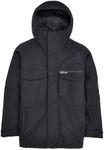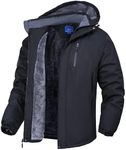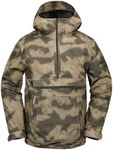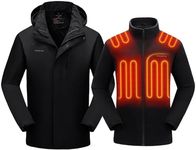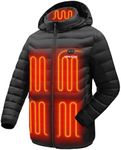Buying Guide for the Best Snowboard Jackets
Choosing the right snowboard jacket is crucial for ensuring comfort, warmth, and protection while you're out on the slopes. A good snowboard jacket will keep you dry, regulate your body temperature, and allow for freedom of movement. When selecting a snowboard jacket, consider the conditions you'll be riding in, your personal comfort preferences, and the type of snowboarding you'll be doing. Here are some key specifications to help you make an informed decision.Waterproof RatingThe waterproof rating of a snowboard jacket indicates how well it can keep water out. This is measured in millimeters (mm) and ranges from 5,000mm to 20,000mm or more. A higher rating means better waterproofing. If you often ride in wet, heavy snow or rainy conditions, look for a jacket with a higher waterproof rating (15,000mm to 20,000mm). For drier, colder climates, a lower rating (5,000mm to 10,000mm) may suffice. Your riding environment should guide your choice here.
BreathabilityBreathability is how well a jacket allows moisture from sweat to escape. This is measured in grams (g) and typically ranges from 5,000g to 20,000g. Higher breathability is important if you tend to sweat a lot or if you engage in high-intensity snowboarding. For casual riders or those in colder climates, a lower breathability rating may be adequate. Consider your activity level and how much you sweat when choosing the breathability rating.
InsulationInsulation in a snowboard jacket helps keep you warm. Jackets can be insulated with down, synthetic materials, or have no insulation at all (shell jackets). Down insulation is very warm but can lose its insulating properties when wet. Synthetic insulation is less warm but retains heat better when wet. Shell jackets offer no insulation but allow for layering underneath. Choose based on the temperatures you'll be riding in and your preference for layering.
FitThe fit of a snowboard jacket affects your comfort and mobility. Jackets come in various fits such as slim, regular, and relaxed. A slim fit is more form-fitting and may be preferred by those who want a sleek look and less bulk. A regular fit offers a balance between comfort and mobility, suitable for most riders. A relaxed fit provides more room for layering and freedom of movement, ideal for freestyle riders. Consider your style and the type of snowboarding you do when selecting the fit.
Seam SealingSeam sealing prevents water from seeping through the seams of the jacket. There are fully taped seams and critically taped seams. Fully taped seams offer the best protection and are ideal for wet conditions. Critically taped seams are sealed in the most vulnerable areas and may be sufficient for drier conditions. If you expect to be in wet environments, opt for fully taped seams. For less wet conditions, critically taped seams may be enough.
HoodA hood on a snowboard jacket provides extra protection against wind and snow. Some hoods are helmet-compatible, meaning they can fit over a helmet, while others are not. Adjustable hoods allow for a better fit and more versatility. If you wear a helmet, ensure the hood is compatible. If you prefer more protection from the elements, look for a jacket with an adjustable hood.
PocketsPockets in a snowboard jacket offer storage for essentials like your phone, wallet, and snacks. Look for jackets with a variety of pockets, including hand-warmer pockets, chest pockets, and internal pockets. Some jackets also have specialized pockets for goggles and media devices. Consider what you need to carry with you on the slopes and choose a jacket with enough pockets to accommodate those items.
VentilationVentilation features, such as pit zips, allow you to regulate your body temperature by letting excess heat escape. This is especially useful during intense activity or warmer days. If you tend to overheat or ride in varying temperatures, look for a jacket with good ventilation options. If you ride in consistently cold conditions, ventilation may be less of a priority.



